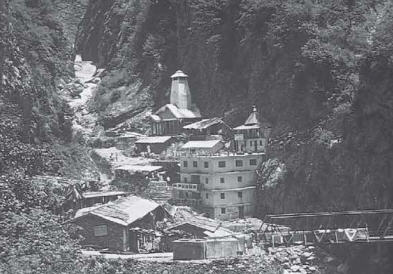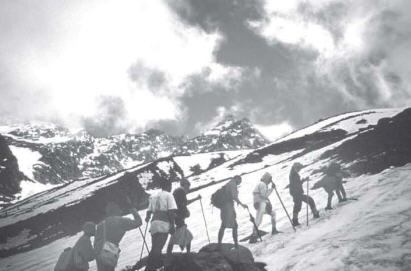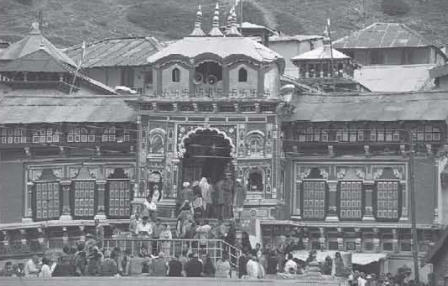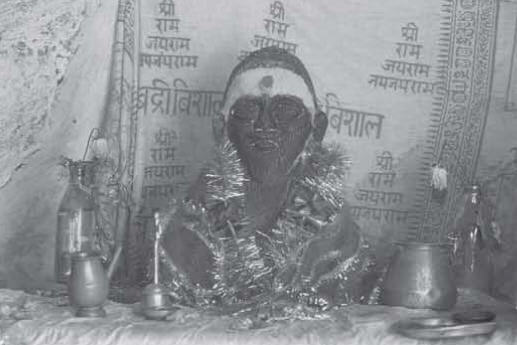Journey To The Land Of The Gods
ISKCON's perennial pilgrims travel to the holiest sites in the world's greatest mountains.
IN 1995, SMALL GROUPS of Hare Krsna devotees travelled throughout India collecting sacred water with which to bathe murtis, or carved forms, of Srila Prabhupada on the one-hundred th anniversary of his birth. One group, ISKCON's India Padayatra party, which continuously travels around India on foot, went on a pilgrimage ro the four holiest sites of the Himalayas: Yamunotri, the source of the Yamuna River; Gangotri, the source of the Ganges River; Kedarnath, dedicated to Lord Siva; and Badrinath, dedicated to Lord Visnu. [Note: For the names of places mentioned in this article, we haven't Sanskritized the spellings or used diacritical marks. Instead we've kept the popular spellings, just as they were sent to us.-Editors]
YAMUNOTRI
We started by foot from Rishikesh, leaving behind the Deity cart and bulls that usually travel with us, and first went to the Yamunotri Valley via Teri and Barkuth. Then from Yamunotri we trekked to Saptarishi Kund, the actual source of the Yamuna River, where the seven rsis performed austerity. It was a difficult trek, and would have been impossible without a guide.
Yamunotri is 3,185 meters above sea level, and Saptarishi Kund is at 4,421 meters. We had to go through snow and ice to reach the kund. When we got there we discovered that there was not only one kund but seven of them. We were so exhausted we couldn't go beyond the first one. We collected the sacred water and descended to the Yamunotri Valley.
GANGOTRI
After a few days, we started on our way to Gangotri. By road the journey would take several days, so we chose to go cross-country, only fifty kilometers.

Our first stop along the way was in Dodital, where Lord Ganesa had appeared. Dodital lake is set in a beautiful lush forest. As soon as we arrived at the bank of the lake, we all felt peaceful. Sitting inside the temple, we listened to the story of Lord Ganesa:
Once Parvati Devi wanted to bathe privately in the beautiful lake. From the dirt of her body she created a boy and told him to guard the valley and not let anyone approach. While she was bathing, Lord Siva arrived and became angry at the boy blocking his path. A fight ensued, during which Siva beheaded the boy.
When Parvati heard what had happened, she became furious. She informed Lord Siva that he had killed his own son. On hearing this, Siva sent some of his followers to the forest and told them to take the head of the first living being they saw and bring it to him. They found an elephant, cut off its head, and brought it to their lord, who fixed it to the boy's body. Thus Ganesa was "born."
We spent the night on the path that encircles the newly built temple. The original, ancient temple was destroyed in an earthquake in 1991. Someone told us that an aerial view of the lake reveals its shape as an elephant's head, whose trunk is the source of the Asi River.
We then walked through the district town of Uttarkasi and soon reached Gangotri, where we stayed for three days, enjoying the wonderful weather.
From Gangotri it is just eighteen kilometers to Gaumukh, the source of the Bhagirathi Ganga River. Vedic scriptures say that when the Ganga, or Ganges, descended from the heavenly planets to earth, to break Ganga's fall Lord Siva caught her on his head. From Lord Siva's head she diverged into many parts. The main part cascaded into the area of Gaumukh and formed the Bhagirathi.
Where the Ganga hit the earth, the altitude was so high that the river froze, so at the source it's a glacier. Sitting nearby, you can always hear the ice moving and cracking. Many years ago the source of the Ganga was in Gangotri itself. But because of climatic changes and the increase of sinful activities in Kali-yuga, the present age, it now takes two days to walk to the source of the river.
Ganga does not start out as a small , trickling stream but as a heavy rush of water flowing from under the glacier. In Gangotri you can always hear the roar of the river and the rolling of big boulders under the surface.
From Gangotri five members of our party went up to Kedartal. Gangotri is situated at 3,200 meters, and Kedartal is above 5,000 meters. The distance between the two is about 18 kilometers, so the climb is steep. On top of Kedartal is a beautifullake. When I asked a swami who had been living in Gangotri for more than fifty years about Kedartal, his eyes lit up. "Blue mani [j ewell," he said, "just like Krsna's face!"
KEDARNATH
After Gangotri we went to Mala, where the ancient trail between Gangotri and Kedarnath begins. We hired a mule to carry Srila Prabhupada's books, our cooking equipment, and our articles of worship. On our way to Kedarnath, we stopped in Buda Kedar, which means Old Kedarnath. This is where the Dharma Ganga and the Balanga Ganga join.

From there we went to Triyuginarayana, where Lord Siva and Parvati married. Lord Narayana performed the marriage, Lord Brahma the accompanying sacrifice. The marriage fire, lit in a former age, is still burning today.
We then proceeded to Gauri Kund, in the Kedarnath Valley. There's a welcome hot kund there, where you can bathe and relax your sore muscles. Parvati Devi as Gauri performed austerities there for thousands of years and finally won the hand of Lord Siva.
On the last stretch to Kedarnath (3,584 meters high) there is no road. Many people go by mule, on a palanquin, or in a basket strapped to someone's head. !t's a difficult walk.
Of the four dhamas, Kedarnath is the highest and most picturesque. We stayed there for about five days, collecting water in the surrounding areas.
We then went to Churabari Kund, the source of the Mandikini River, and on the way we saw the Brahmakamal Phul, the flower Bhima brought from Brahma's planet for Draupadi. The flower doesn't look like anything special, but the scent of it would fill a room for a week. After four days we returned to Gauri Kund, passing five temples of Kedarnath, or Lord Siva. And as we went, we learned of their history:
After the Battle of Kuruksetra, the Pandavas went to see Lord Siva in Kasi to atone for killing so many of their kinsmen in battle. When Lord Siva learned that the Pandavas were coming, he fled and playfully hid from them. The Pandavas discovered Siva in the Himalayas, in a place called Gupta Kasi ("Hidden Kasi"), where he had disguised himself as a brahmana. Having been found out, Lord Siva ran away to a valley and disguised himself as a bull, but Bhima recognized him. Bhima stretched his big legs from one end of the valley to the other and caught the bull by its tail. Lord Siva, still trying to hide, began to bury himself in the ground. But the determination of the Pandavas won him over, and before the bull's hump had disappeared, he decided to give them his audience.
Lord Siva instructed the Pandavas to worship the hump of the bull, and worship is still going on in the temple they established. Other parts of Lord Siva's body appeared in other mountains, and the Pandavas also built temples there. They are known as Panch Kedars (five Kedars): (1) Kedarnath-hump, (2) Tuganath-arm, (3) Rudranathface, (4) Kalpeshwar-hair, and (5) Madhyamaheswar-navel.
BADRINATH

The last stretch of our pilgrimage, Kedarnath to Badrinath, took nine days. While travelling from one valley to the next, we noticed that the people are devotees of the local presiding Deities. In the Yamuna Valley people would greet each other saying," Jaya Yamuna Mayi!" In Gangotri Valley they would say, "Ganga Mayi ki jaya!" in Kedarnath, "Jaya Kedar!" and in Badrinath, "Badrivishal ki jaya!"
On the way to Badrinath we stopped in Joshimath, where Adi Sallkaracarya performed penance and got the realization to compile the scriptures that defeated Buddhism and reintroduced Vedic principles.
From Joshimath we went to Vishnu Prayag, one of the five prayags (confluences) of different branches of the Ganga between Rishikesh and Badrinath. Pilgrims are advised to bathe in these five prayags on their way to Badrinath. Nowadays, most people go by bus or car and miss the privilege of the transcendental dips.
From Vishnu Prayag to Badrinath is only about forty kilometers. On the way we passed Pandukesvar, where King Pandu had lived and the Pandavas were born. As there are five Kedars, so there are five Badris. Pandukesvar is one of them. Up a little higher we came to Hanuman Chati, where Bhima's pride was shattered:
One day as Bhima was walking on the trail, he came across a monkey whose tail was lying on the path. Asked to move its tail, the monkey retorted that Bhima should lift it himself. In spite of repeatedly trying, Bhima couldn't move the tail. Eventually the monkey revealed himself as Hanuman , Bhima's brother.

Deities of Badrinath
From Hanuman Chati up to Badrinath is a steep trek. The day we walked, the Ganga had overflowed and was eating away the road. After a long struggle, we eventually crossed the water. It was a difficult and dangerous enterprise. Many rocks were hitting our legs, and the water was icy. Freezing and wet, we finally got to Badrinath Dham, having been reminded that to enter holy sites of the Lord's pastimes may be difficult.
Beyond Badrinath lies Mana, where Srila Vyasadeva, the compiler of the Vedic scriptures, is said to eternally reside in a cave, meditating on Lord Krsna. From the cave it's just a short walk to Bhima's bridge, a huge piece of rock thrown across a narrow valley. A little further the Sarasvati and Alakananda rivers meet. Another one and a half kilometers farther is the place where Draupadi passed from this world. Farther a long the path, Nakula and Sahadeva left, then Arjuna, Bhima, and finally Yudhighira. We bathed in the confluence, joyful at having completed our pilgrimage to the four dhamas.
We felt satisfied that we'd gathered water for Srila Prabhupada's sacred bath from many remote holy sites. But perhaps our greatest satisfaction came from having been able to distribute Srila Prabhupada's books in places where no ISKCON devotees had gone before. Many of the people we met could not read or write, but we gave out hundreds of small pictures of Srila Prabhupada and announced his Centennial celebrations to the residents of the land of the gods.
]aya Vijaya Dasa has been a leader of ISKCON's India Padayatra since it began in 1984.
